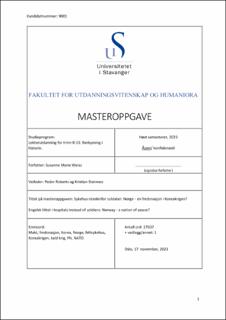| dc.contributor.advisor | Roberts, Peder | |
| dc.contributor.advisor | Steinnes, Kristian | |
| dc.contributor.author | Weisz, Susanne | |
| dc.date.accessioned | 2024-01-10T16:51:15Z | |
| dc.date.available | 2024-01-10T16:51:15Z | |
| dc.date.issued | 2023 | |
| dc.identifier | no.uis:inspera:178827520:23189225 | |
| dc.identifier.uri | https://hdl.handle.net/11250/3110910 | |
| dc.description.abstract | Koreakrigen var en væpnet konflikt som varte i perioden 1950-1953. Dette var en krig mellom Nord- og Sør-Korea, der nord fikk støtte fra Sovjetunionen og Kina, mens Sør-Korea fikk støtte av USA-ledede vestlige styrker. På grunn av både medlemskap i NATO og FN deltok også Norge i denne krigen.
Denne oppgaven tar for seg den norske utenrikspolitikken i den kalde krigen, med spesielt fokus på hvordan Norge har fremstilt seg som en fredsnasjon igjennom det norske feltsykehuset i Korea. I sammenheng med dette har denne studien også tatt for seg og drøftet ulike typer maktbruk, forholdet Norge hadde til FN, NATO og USA under Koreakrigen. Problemstillingen som ligger til grunn for denne oppgaven er: Hvorfor valgte Norge å bidra med et feltsykehus under Koreakrigen?
For å svare på problemstillingen baseres empirien i denne oppgaven på arkivmateriale. Det teoretiske grunnlaget baseres på tre ulike dimensjoner av begrepet makt; synlig, skjult og usynlig makt. Disse blir basert på Robert A. Dahl, Peter Bachrach og Morton S. Baratz og Joseph Nye. Teorier om begrepet fredsnasjon og Norges utenrikspolitikk i FN tas også i bruk.
Gjennom en narrativ innholdsanalyse av utvalgt arkivmateriale finner denne studien ut av at det norske feltsykehuset var gunstig for alle parter. Å bidra med et militært feltsykehus som hjelper skadde og lidende mennesker, i motsetning til å sende soldater, kan bli ansett som et humanitært bidrag, til tross for at det var av militær art. På denne måten kunne et slikt bidrag forsterke det norske ryktet som en fredsnasjon, samtidig som at de politiske kravene til både FN og USA igjennom medlemskapet i NATO ble oppfylt. | |
| dc.description.abstract | The Korean War was an armed conflict which lasted from 1950-1953. The war was between North and South Korea; the North received support from the Soviet Union and China, while South Korea received support from US-led Western forces. Due to the membership in NATO and the UN, Norway also participated in this war.
This thesis deals with Norwegian foreign policy during the Cold War, with special focus on how Norway has promoted itself as a nation of peace through the Norwegian field hospital in Korea. In connection with this, this study will also address and discuss different types of use of power, Norway's relationship with the UN, NATO, and USA during the Korean War. The research question in this study is: Why did Norway choose to contribute with a field hospital during the Korean War?
The empirical data in this thesis are based on archival material. The theoretical foundation is based on three different dimensions of power; visible, hidden, and soft power. These are based on theories to Robert A. Dahl, Peter Bachrach and Morton S. Baratz and Joseph Nye. Theories about the concept of a peace nation and Norway´s foreign policy in the UN are also used.
Through a narrative content analysis of selected archive material, this study finds that the Norwegian field hospital was beneficial to all parties. Contributing with a military hospital, which helped injured and suffering people, as opposed to sending soldiers, can be considered a humanitarian contribution, despite the fact that it was of militant nature. Such a contribution could strengthen the Norwegian reputation as a peace nation, while at the same time fulfilling the political requirements for both the UN and the United States through membership in NATO. | |
| dc.language | nob | |
| dc.publisher | uis | |
| dc.title | Sykehus istedenfor soldater: Norge - en fredsnasjon i Koreakrigen? | |
| dc.type | Master thesis | |
